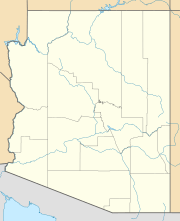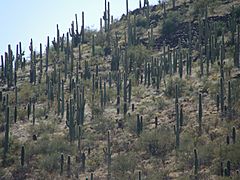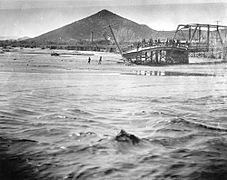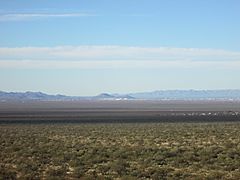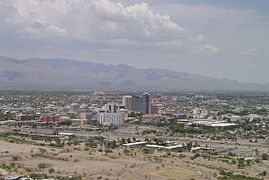Sentinel Peak (Arizona) facts for kids
Quick facts for kids Sentinel Peak |
|
|---|---|
| "A" Mountain | |
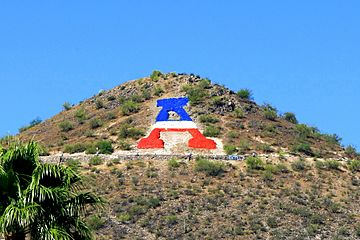
The "A" on Sentinel Peak, pictured with its 2003-2013 color scheme.
|
|
| Highest point | |
| Elevation | 2,901 ft (884 m) NAVD 88 |
| Prominence | 267 ft (81 m) |
| Geography | |
| Location | City of Tucson Pima County, Arizona, U.S. |
| Parent range | Tucson Mountains |
| Topo map | USGS Tucson |
Sentinel Peak is a cool mountain in Tucson, Arizona. It stands about 2,897 feet (883 meters) tall. This peak is part of the Tucson Mountains. Long ago, the first people living in the valley grew crops at its base. The city's name, Tucson, comes from an old word meaning "the base [of the mountain] is black." In the 1910s, students from the University of Arizona built a giant "A" on the mountain. This is why many people call it "A" Mountain. It's also part of a big park, covering 272 acres, which is the largest natural park in Tucson.
Contents
A Mountain's Early History
The land at the bottom of Sentinel Peak was very good for farming. People grew food there for thousands of years, starting around 2000 BCE. They used special rocks on the mountain to grind corn and mesquite beans into flour. In the late 1600s, a visitor named Eusebio Francisco Kino met the O'odham people living here. He helped start a nearby mission.
Later, in 1775, a fort called Presidio San Agustín del Tucsón was built. Guards, called sentinels, stood on the peak. They watched for approaching Apache groups. Today, a place called Mission Garden at the mountain's base shows this long history of farming.
How Sentinel Peak Was Formed
Sentinel Peak is made of many layers of igneous rock. This rock comes from volcanic activity long ago. But don't worry, the mountain itself is not an active volcano! It's one of several hills at the edge of the Tucson Mountains. These hills are mostly what's left of ancient lava flows. These flows happened about 20 to 30 million years ago.
Over millions of years, erosion (wind and water wearing away rock) and faulting (cracks in the Earth's crust) shaped the peak. That's how it got its cone-like shape. The very top layer of rock is a type of basalt from about 23 to 24 million years ago. Below that is a thick layer of tuff, which is compacted volcanic ash. You can also find old lava beds on the mountain. These are all clues that this area was once a very active volcanic place.
Why It's Called Sentinel Peak
Have you ever wondered how Sentinel Peak got its name? A historian named David Leighton explained it in 2016. He wrote that long ago, people built a small fort on top of the mountain. This fort became known as the sentinel station. A sentinel, or guard, was always posted there. Their job was to watch for any groups that might be approaching.
During the U.S. Civil War, soldiers were stationed there. They even put up a canvas roof to block the sun. By 1883, only parts of the old fort remained. There was a circular wall made of boulders. There were also traces of other small walls. Even in 1925, some ruins were still there. So, the name Sentinel Peak comes from those guards and their watch station.
The Famous "A" on the Mountain
The giant "A" on Sentinel Peak has a fun story! In 1914, the University of Arizona football team won a big game. A student on the team, who studied civil engineering, had an idea. He convinced his professor to make a class project. The project was to design and build a huge block "A" on the mountain.
Students worked hard to complete the project. On March 4, 1916, the "A" was finished. It was 70 feet (21 meters) wide and 160 feet (49 meters) tall. They painted it white on the east side of the peak. The rocks used to build the "A" came from a quarry at the mountain's base. This quarry also provided stone for many buildings in Tucson.
The "A" is usually painted white. But sometimes, it changes color for special reasons. In 2003, it was painted red, white, and blue to honor American troops. Later, it went back to white. It has also been painted green for St. Patrick's Day. In 2018, it was painted red to support teachers. In 2020, it turned blue to thank healthcare workers during the COVID-19 pandemic. In 2024, it was painted with different colors to show support for a cause, but it was soon changed back.
Another university, Arizona State University (ASU), also has an "A" on a mountain near their school. When the Arizona and ASU football teams play, fans sometimes try to paint the other school's "A" with their own team colors!
Gallery
-
Tall saguaros growing at the bottom of Sentinel Peak
See also
 In Spanish: Picacho del Centinela para niños
In Spanish: Picacho del Centinela para niños
- List of mountains and hills of Arizona by height
- University of Arizona
- List of hillside letters in Arizona
- Y Mountain


